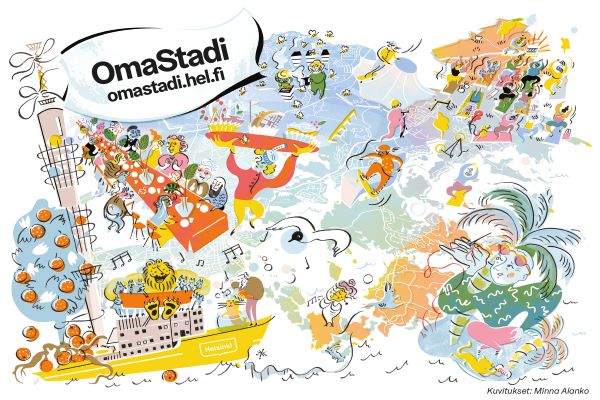
The Quest for Efficient Deliberation and Proximity Democracy: The Case of Participatory Budgeting in Helsinki

This is part of our special feature, Sustainable European Cities and Digitization.
Participatory budgeting is a rapidly growing democratic innovation with promises to alter citizens’ participation significantly. In the last thirty years, it has spread to thousands of cities with around 11,000 reported cases around the world, and with very different models of collaboration, co-creation, and democracy. The participatory processes balance between inclusive deliberative strategies and practices of efficient facilitation and decision-making. They rely increasingly on the combination of digital as well as face-to-face interaction.
In a nutshell, in participatory budgeting, various groups, such as residents, public sector actors, organizations, and companies, engage in a dialogue over money and resources in order to establish a consensus over their use. In Helsinki, the dialogue has occurred mostly between citizens and city administrators in that residents propose initiatives within the budget limit, then vote on the ones they favor with the City of Helsinki implementing the winning proposals soon after the vote.
Based on our extensive evaluation of a participatory budgeting (referred to as PB thereafter) pilot called OmaStadi (Rask, Ertiö & Tuominen, et al. 2020), we discuss here how the dynamics between deliberation and competition have unfolded at the city level, both in virtual encounters and in-person meetings. The evaluation carried out by the authors is based on the “Co-creation Radar” (Rask & Ertiö, 2019), which is a comprehensive public participation evaluation model. The analysis here describes the successes and failures at different phases of OmaStadi, with an emphasis on different understandings of successful democracy and interaction among the participants.
The city of Helsinki started OmaStadi in 2018 with an allocated budget of 4.4 million euros, doubled to 8.8 for the second round in 2020–2021. In the pilot, the path from ideation to the voting stage took roughly a year and revealed competing dynamics of how the sense of locality emerges throughout the participatory process, both as collaboration and rivalry. The pilot took place within Helsinki’s unique sociocultural setting, but the process was influenced by the diverse models and experiences of PB and other forms of proximity democracy around the world.
The Scale and Scope of Participatory Budgeting
Forms of PB vary in scale. The budget for the first round of Helsinki’s OmaStadi comprises 0,1 percent of the city budget – in Paris the funding has been around 1 percent of the city budget and the highest figures can be found in the Brazilian cities that initiated PB in the late 1980s: Porto Alegre has allocated around one fifth of its city budget for PB and in Belo Horizonte the figure has risen to around the 50 percent mark. However, it is important to note that the democratic process can be very different: there are models of PB based on a straightforward submitting and voting on citizen proposals, while more complex procedures—usually applied in higher budget contexts—stress various methods of deliberation, from models of co-creation to elements of representative democracy, such as elected citizen councils. The participants in our study emphasized the importance of genuine participation, the feeling of building something new and significant together, rather than being puppets in a script that someone else has written.
However, numbers and percentages do not tell the whole story. In Helsinki, the sum of 4,4 million euros could be a lot or next to nothing, depending on the perspective. For one decision maker interviewed, it represented “the margin of error in the annual budget of the division of social services and healthcare,” while an urban activist pointed out that the sums distributed are “simply astronomical” for many: “They don’t understand that the urban activists in Helsinki are doing things completely free-of-charge or maybe with a budget of a few thousand euros. Compared with that these 4.4 million euros is a ridiculously large sum of money.”
There are also differences in the scope and aims of PB in different contexts. There can be a specific focus for the proposals, such as ecological or social well-being, or the proposals can be targeted for a specific group, such as the disadvantaged youth or other marginalized citizens. The aim here is usually to draw attention to groups whose voices are often neglected and to increase their participation.
At the other extreme, PB can also act as a technocratic management tool. In Solingen, Germany, the PB process was inverted and the citizens voted on budget cuts, not proposing new initiatives. In the OmaStadi process of Helsinki, the rules were broad-ranging: the minimum budget for a proposal was 35,000 euros and the maximum 288,390–653,250 euros, depending on the number of residents in a district. Other than that, the funding could not be applied to employ permanent personnel or to establish permanent activities. The proposals had to be within the jurisdiction of the city and, of course, to be within the limits of the law.
The voter turnout in Helsinki was higher than expected—almost 50,000 residents (8.6 percent of the population) gave their vote on the first round of OmaStadi. Internationally, the highest percentage has been in Cascais, Portugal (32 percent in 2019), while Paris (5.4 percent in 2018) and New York (1.2 percent in 2016–2017) are behind Helsinki in this respect.
Perhaps one reason for the popularity of PB in different contexts lies in its focus on small and easily conceivable localities and the tangibility of the citizens’ proposals. PB projects usually take place on the city level and the budget is shared between its neighborhoods or districts. However, PB also has been used at the national level in Portugal as well as the village level, or even at the level of an individual park or school. In the OmaStadi model, the City of Helsinki is allocating PB funding both at the district and the city levels for initiatives focusing on the entire area. Every resident over twelve years of age can vote for the proposals at the district as well as the city level.
In our evaluation, we found out interesting differences between initiatives at the district and city-wide implementation levels. The former were much more specific and straightforward, with suggested improvements for local infrastructure, particularly sports and outdoor recreation facilities. On the city-wide implementation level, proposals focused primarily on ecology, equality, and accessibility as well as the more innovative initiatives.
Deliberation and Competition
The global trajectory of PB consists of various competing approaches, with different principles, rules and power relations. While the first cases in Brazil were attempts to develop a radically new kind of democracy and to question the functioning of the existing institutions, nowadays a great majority of PB projects take more modest approaches. Their aim is to develop new relationships between citizens, officeholders and decision-makers and to submit new political priorities for implementation. In Helsinki, since its initiation in 2018, PB has become an arena where very different expectations are realized via participatory dialogue.
In our research, in addition to the data collected regarding voting and feedback surveys, we observed participants at project events, conducted interviews with political decision-makers, NGOs, community representatives, and relevant city experts involved during the development of the process. In the data, the rift between different positions was clear. The opposition can be framed as shifting emphasis between deliberative democracy and increased efficacy. However, the positions taken on the matter are not straightforward polar opposites but borrow from different ideas and experiences of PB.
In the OmaStadi model, the proposal topics are quite open. They are not narrowed down thematically but other kinds of guidelines exert influence on the process. OmaStadi model allows proposals that are short-term rather than permanent and their budget has to be set in advance. In Helsinki, almost two thirds of winning proposals fell under the responsibility of the division of Urban Environment. The divisions of Social Services and Health Care, Education, and Culture and Leisure received relatively few proposals, perhaps because the rules encourage spending on non-recurrent investments, rather than projects involving lengthy development work, more typical for their fields.
These constraints on the long-term impact gave rise to frustration among some of the participants. Despite the supposed openness to the wide range of topics, the model itself was seen as constricting democracy into straightforward processes of writing down ideas and voting on them. The deliberative element was not given enough space and the process discouraged democratic organizing with larger aims. This view was often countered with a positive emphasis on the straightforward process. Participation into OmaStadi did not require attending lengthy meetings and exhaustive dialogues, nor familiarization with complex procedures of deliberative decision-making.
The results of the vote reflected the properties of the OmaStadi model. The fourty-four winning proposals had mostly a very matter-of-fact character: sports facilities were improved, park benches installed, flowers and trees planted and other infrastructural qualities reinforced. Very few proposals concentrated on structural changes within city administration and only a few challenged the status quo. Many of the more imaginative ideas were not approved for the proposal stage because they did not meet the requirements of the OmaStadi model. Within the global comparative framework, OmaStadi is situated closer to the models facilitating new communication channels and improving urban infrastructure rather than challenging the existing system and setting in motion radically new forms of democracy. Deliberation is integral to the process, but it follows the clear and efficient structure assigned in advance.
Digital and Face-to-Face Deliberation
We also observed how interactions among partners took place on digital platforms and in face-to-face encounters during the process. In the different OmaStadi stages, from ideation to development of a final proposal, and further into cost estimate and voting, communication involves both digital and direct in-person components (Ertiö, Tuominen & Rask, 2019). The overall feedback from the workshops, especially the OmaStadi Raksa concept, where citizens developed their ideas together with experts from city administration, was positive and the meetings encouraged participants to improve their proposals together. In addition to improving the proposals, the events helped to increase understanding of city operations and desires of its citizens.
In contrast, the shift to Decidim, a globally used platform developed for citizen participation, resulted in some confusion and frustration. Lively workshop discussions quieted down and the platform mostly served as a channel for the city to comment on existing proposals and to inform participants of next steps within the process. The existing chat function did not provide an environment that would encourage participants to exchange in-depth views. While digital communications have been improved for the second round of OmaStadi, the organisers acknowledge the need to support face-to-face participation throughout the process. However, for the second round the process has been markedly different because of the Covid-19 pandemic.
The sparse discussion on the digital platform stood in stark contrast to the fair amount of publicity of PB in mainstream media and social media channels of urban activists. OmaStadi was first introduced as a fresh initiative with a distinctive urban flavor but soon many stories and commentaries adopted a perspective focused on competition. For most of the mass media, stories of tense competition are preferred to analyses of rigorous deliberation.
For the success of the process, this was a double-edged sword. The sense of competition energized participants to spread the word on PB. At the same time, some campaigns started to spread false information about competitors. Despite the fact that the great majority of participants behaved in an amicable manner, few conflicts caught the attention of many. In the most notorious case, the juxtaposition between an improved football pitch for local youth and the bohemian hang-around with an emphasis on new urban culture evolved into a passionate and bitter rivalry for last-minute votes. The emphasis shifted from a deliberative process with shared goals to a contest defined by marketing skills and networks.
On the positive side, this increased the awareness of PB: the voter turnout in the district where campaigning was most heated was threefold in comparison to the lowest figure in Helsinki. However, it is possible that this antagonist image becomes closely associated with the whole OmaStadi process in the future, instead of its deliberative characteristics. The second round of OmaStadi is currently underway with nearly all interaction in digital environments because of the Covid-19 pandemic. It remains to be seen what effects this has on the dynamics of deliberation and competition.
On the basis of our evaluation results, we recommend the following seven points to improve OmaStadi:
- Develop OmaStadi in coherence with the concept of proximity democracy, to ensure that the long-term connections to urban area development will be strengthened. The establishment of citizen forums is proposed to encourage better cooperation with local stakeholders in the development and cost estimation phases of a proposal.
- Maintain equity as a central tenet. Minority groups were under-represented in the planning and implementation stages. Reaching and activating minority groups requires efforts in multilingual and accessible language practices, as well as in long-term cooperation with NGOs and community groups.
- Shift attention from voting to deliberation. The voting system used in the pilot led to fierce competition in some areas and perceptions of tactical voting. In the future, it is important to create more space for debate on proposal content.
- Delineate OmaStadi objectives. The scale of funds allocated through participatory budgeting, links to various democracy models, and the role of sustainability revealed contradictory expectations. Shared goals would support OmaStadi’s long-term development.
- Support OmaStadi’s future development through research and evaluation. International examples have shown that unbiased evaluations support learning through experimentation considerably. Evaluation should remain an integral part of process development.
- Make OmaStadi results and impacts more visible. Based on the feedback received, citizens were unaware of what happened to the proposals they voted for. Alongside communication channels already in use, OmaStadi-branded logos could be considered to identify winning proposals.
- Heighten participation of NGOs, businesses, and research organizations in OmaStadi. This could be implemented by co-creation events, hackathons, and similar gatherings.
Participatory budgeting is not a neutral tool that guarantees straightforward and equitable participation. Despite its relatively recent introduction just thirty years ago, there are already competing trajectories of PB arranged in line with parallel sets of values. The debates on the balance between deliberation and efficacy are central to PB in different contexts. New forms of participatory democracy convey diverse expectations in the minds of the participants and result in conflicts when they clash. The underlying assumptions of the participants that realized in dialogue, both face-to-face and virtually. Despite its modest 0,1 percent share of the city budget, it has quickly become an important arena where many future guidelines of democracy and participation are negotiated in the urban context of Helsinki.
Pekka Tuominen, Mikko Rask and Titiana Ertiö are the authors of the Final Evaluation of the City of Helsinki’s Participatory Budgeting: OmaStadi 2018–2020, conducted within the University of Helsinki / BIBU project (312710) funded by the Strategic Research Council. The project was also supported by the COST project Dynamics of Placemaking and Digitization in Europe (18204/DOPMADE) and the NordForsk project Collective Intelligence through Digital Tools (100855/COLDIGIT )
References
Ertiö, T-P., Tuominen, P. & Rask, M. 2019. Turning Ideas into Proposals: A Case for Blended Participation During the Participatory Budgeting Trial in Helsinki, Lecture Notes in Computer Science; vol. 11686, p. 15-25. Electronic Participation: ePart 2019.
Rask, M. & Ertiö, T. 2019. The Co-creation Radar – A Comprehensive Public Participation Evaluation Model. Publications of the BIBU project. https://bibu.fi/policy-brief-the-co-creation-radar-a-comprehensive-public-participation-evaluation-model/
Rask, M., Ertiö, T., Tuominen, P. & Ahonen, V. 2020. Final Evaluation of the OmaStadi Participatory Budgeting in Helsinki 2018–2020). Publications of the Ministry of Justice. https://bibu.fi/final-evaluation-of-helsinki-participatory-budgeting/
Published on May 11, 2021.




